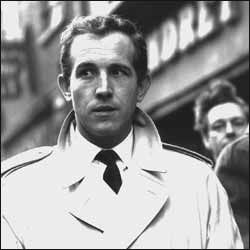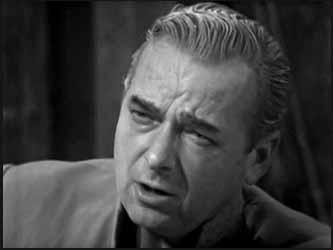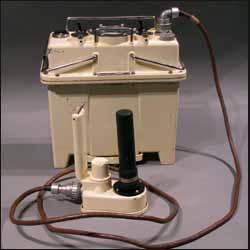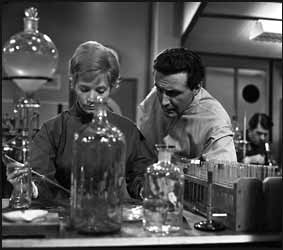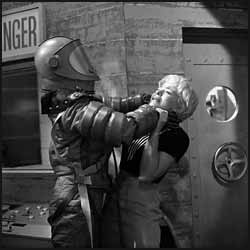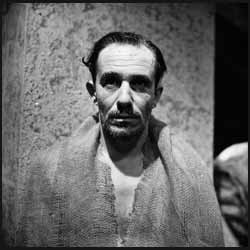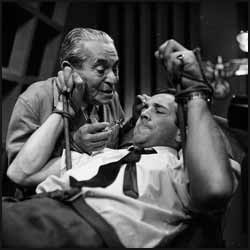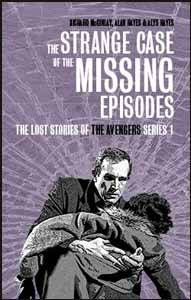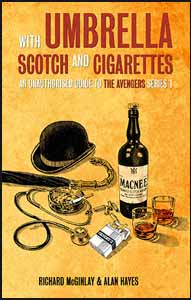|
Click here to return to the main site. The Radioactive Men - The Avengers Goes Sci-Fi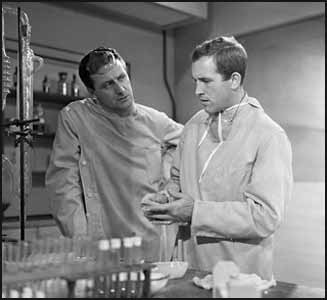 We all know that the 1960s British television series The Avengers ended on a supremely fantastical note, with secret agent John Steed and fellow spy Tara King blasting off into space – without a chaperone! But when did the show make its first forays into the realms of science fiction? Was it the killer robots of the Emma Peel adventure The Cybernauts? Was it the supercomputer Plato in the Cathy Gale episode The Big Thinker? No, it was even earlier than that. Avengers historian Richard McGinlay argues that the programme’s first small steps into sci-fi were actually taken during its debut year, in episodes that no longer exist today... The mostly missing 1961 series of The Avengers, starring Ian Hendry as Dr David Keel and Patrick Macnee as John Steed, are often remembered – if they are remembered at all – as being gritty spy thrillers, with few if any of the fantastical elements for which the show would ultimately become world-famous. This impression has been reinforced over the decades by a lack of surviving footage – only two complete Keel episodes exist, plus the first 15 minutes of the opening episode, Hot Snow – and by a set of widely proliferated publicity stills, taken in December 1960, which show Hendry and Macnee in stereotypical ‘sleuthing’ mode, clad in raincoats and puffing away on cigarettes. Fortunately, the true and diverse nature of Series 1 has become somewhat better known in recent years, thanks to visual reconstructions of several missing episodes on StudioCanal DVD releases (made possible by the discovery of off-screen stills known as Tele-Snaps); reference guides such as the website The Avengers Declassified and the books The Strange Case of the Missing Episodes and With Umbrella, Scotch and Cigarettes; and full-length audio adaptations by Big Finish. It has become clear that in addition to hard-boiled storylines such as drug dealing in Hot Snow and counterfeiting in Square Root of Evil, there were also more light-hearted subjects and settings, such as trips to a zoo in Please Don’t Feed the Animals and visits to a fun fair in Tunnel of Fear. Such elements were often starkly contrasted within the same episode, such as the combination of cold-blooded murder and cha-cha-cha lessons in Dance with Death, or a call-girl racket set against the apparently innocent environment of a children’s toy department in Toy Trap. A surprising number of Series 1 episodes also incorporated science-fiction elements...
The earliest Avengers episode with a scientific theme was probably Nightmare. Its plot concerned an eminent scientist, Professor Braintree, who is engaged in top-secret research and whose disappearance may be linked to a group of unscrupulous medical men based in a nearby hospital. When Keel is mistaken for Braintree, one of the villains tries to kidnap him. Very little is known about this story apart from some rather scant synopses, but it seems likely that the professor’s research has some kind of medical application, presumably a potentially lucrative one, hence the interest from the men at the hospital. When the missing professor finally shows up, it transpires that he has been suffering from amnesia. This fact, together with the title of the episode, might suggest that his work involves psychoactive medication, but that is speculation. A rather more concrete observation regards a laboratory scene from a Series 1 episode, which was recalled by production designer Robert Fuest in Dave Rogers’s 1995 book The Ultimate Avengers: “Peter [Hammond, the director] had this marvellous idea for a fight in a laboratory. The villain fires his gun and the other guy ducks. As the actor ducks, the prop man fires a marble with a catapult and a test tube explodes. We practised this and it worked like a dream in rehearsals. On the live show, the prop man is nervous, shit-scared, because he knows that it’s the longest trajectory in the world. He’s nervous and he blows it. He fires the marble and a glass tank shatters into smithereens.” Though Fuest does not name the episode in question, it is highly likely to have been Nightmare. There seem to be no other episodes of The Avengers directed by Hammond and designed by Fuest that could have featured a laboratory.
Science really came to the fore in The Radioactive Man, though this was more science fact than science fiction. In this well-researched episode, Marko Ogrin, an illegal immigrant from Eastern Europe who is working as a cleaner at the Whitman Research Laboratory, inadvertently becomes the centre of a national emergency when he picks up what he thinks is a harmless lead pellet on a nylon cord. He believes it will make a nice present for his landlady’s young son, who is interested in fishing. In reality, the pellet is a radioactive radium isotope. Ten hours’ exposure to it will be enough to kill Ogrin and anyone he comes into contact with. The episode’s writer, Fred Edge, provided a realistic depiction of the effects of radiation upon the human body, as evidenced by the following exchange between Keel and Dr Graham, a scientist from Ogrin’s place of work. This extract is taken from the surviving camera script for The Radioactive Man: GRAHAM: I’m saying he’s likely to be dead by five o’clock in the morning. KEEL: Is that an outside limit? GRAHAM: Of course, I’m speaking in probabilities. You see, radium doesn’t kill quickly, but, if that capsule’s been in his pocket ever since he took it, he’s dying now… his blood cells are already beginning to break down. After about four hours he’ll have nausea, vomiting, diarrhoea. KEEL: In other words, we haven’t got till five to get him. How long do we have? GRAHAM: If we’re to save him, we’d better find him by one o’clock.
Keel, Graham and the police search for Ogrin, aided by technicians equipped with Geiger counters, scintillometers (which detect small fluctuations in the refractive index of air caused by variations in temperature, humidity and pressure) and radium-sensitive film (which turns cloudy when the substance has been present). However, their efforts are hampered by the fact that Ogrin does not want to be found – he fears that the authorities wish to deport him. Interestingly, The Radioactive Man started out as a standalone television play, which originally aired in Canada in January 1958, as part of the Canadian Broadcasting Corporation’s General Motors Theatre strand (also known as CBC Theatre and General Motors Presents). It was adapted for The Avengers by story editor Patrick Brawn, with Keel’s character taking the place of a protagonist named Shore – played in the CBC version by Cec Linder, who would go on to portray the palaeontologist Roney in the BBC’s Quatermass and the Pit (1958–9) and Felix Leiter in the James Bond film Goldfinger (1964). Owing to its origins, The Radioactive Man is an unusual script for The Avengers. The most prominent character in it is arguably that of Ogrin rather than Keel or Steed (who hardly appears at all). However, there are hints of the more fantastical Avengers to come – particularly in the format of the episode’s title, which would be echoed in later years with The Outside-In Man, The See-Through Man and The Positive Negative Man. More mischief of a medical variety followed in One for the Mortuary and The Yellow Needle. In common with Nightmare, One for the Mortuary concerned the hunt for top-secret pharmaceutical information, in this case microfilm containing the chemical formula for a new wonder drug called Morgantol. In The Yellow Needle, a sinister scientist named Ali develops a deadly new strain of yellow fever, with the aim of assassinating the prime minister of a soon-to-be-independent African nation. Aside from the aforementioned story elements, however, the plots of these episode are more espionage thriller than science fiction.
It was towards the end of Series 1 that sci-fi really came to the fore. Three out of the final four episodes fell into this category, with both The Deadly Air and Dragonsfield taking place in hi-tech laboratories, and Dead of Winter tackling the topic of cryogenics. Unfortunately, The Deadly Air and Dragonsfield seem to have been rather similar to each other in terms of plot. Both episodes concern scientists in advanced research facilities that are being plagued by sabotage, murder, experiments going dangerously wrong and contamination in isolation rooms. As in Nightmare and One for the Mortuary, the motivation in The Deadly Air is financial – a corrupt scientist wants to discredit the vaccine that is being developed at Truscott Research Laboratories, planning to leave once the project has been ruined, then set up elsewhere and sell the vaccine, suitably disguised as his own work. Keel and Steed are threatened with contamination when the saboteur and his accomplice tape a glass phial containing a lethal strain of vaccine to the blades of a fan in the ventilation system. It would appear that at one stage it had been intended to have a live monkey in the studio for this episode. Keel and Steed were supposed to administer a dose of vaccine to the animal, to test whether or not it was safe. This plot element has wormed its way into various reference works over the years, presumably from contemporary synopses, which are not always accurate. However, Tele-Snaps and production photographs clearly show Keel, Steed and a scientist named Heneager performing this experiment upon a live guinea pig. The Avengers production team had worked with a monkey prior to this, in Please Don’t Feed the Animals, so perhaps they had a bad experience that time – or they simply wanted a bit of zoological variety. In common with The Radioactive Man, there is an outside chance that The Deadly Air was based upon a previous script by its writer, Lester Powell, entitled Night of the Plague. This play was produced twice – first in the USA for the National Broadcasting Company under the Kraft Television Theater banner and transmitted in March 1957, then in Canada for the CBC as an entry in the General Motors Presents series, broadcast in June of that same year. Night of the Plague does indeed appear to have contained plot ideas in common with The Deadly Air, though the settings and characters differ. Coincidentally, the Canadian version featured a little-known actor by the name of Patrick Macnee. Whatever happened to him…?
The staff at the facility in Dragonsfield are experimenting with materials intended to protect astronauts from radiation and other hazards encountered in space. However, when a technician is deliberately exposed to a massive dose of radioactivity, Steed is called in. In this episode, the saboteur’s identity is concealed by various kinds of protective suit. Three different types can be seen in surviving photographs, one of them being a standard hazmat (hazardous materials) suit. Another resembles a lightweight spacesuit not unlike that worn by the astronaut Alan Shepard when he piloted the Freedom 7 mission on 5th May 1961 to become the first American in space, just a few months before this episode was recorded. A more forward-thinking design, worn by the saboteur at the very start and end of this story, looks more like the bulky EVA (extra-vehicular activity) spacesuits that would become familiar from 1965 onwards. It is possible that these variations were intended to mislead the audience about the number of saboteurs at work in the research centre – a neat twist on The Deadly Air, in which what initially appears to be one saboteur turns out to be two. In story terms, the two spacesuits may represent different stages in the development of the garment by the scientists at the facility, or they could be intended for different purposes, such as intra-vehicle and extra-vehicle use. As well as a variety of outfits, the saboteur in this episode also favours a variety of methods when attacking victims, ranging from radiation to a pair of remote-controlled mechanical grab-arms, normally used for handling hazardous materials. Coverage of Dragonsfield in the Manchester Evening News on the day of its transmission (30th December 1961) perhaps painted the episode as more fantastical than it actually was, implying that “The Avengers moves on ITV to-night to an atomic research establishment where Barbara Shelley and Sylvia Langova are involved in sinister goings-on in space suits”. The listing in TV Times magazine went further, indicating that Steed “samples outer space”. What the agent actually appears to experience in surviving photographs is an unhealthy dose of atmospheric pressure in the research centre’s isolation chamber.
By far the most fantastical episode of the 1961 series has to be Dead of Winter, which was the last instalment of Series 1 to be recorded. In this adventure, Keel and Steed uncover a plot to cryogenically freeze members of a Neo-Nazi group known as Phoenix. The plan is to incite a nuclear conflict, which would eradicate all of Phoenix’s enemies, as the organisation’s chief scientist Kreuzer explains to Keel in this extract from the surviving rehearsal script: KEEL: Atomic war is pretty indiscriminate, Kreuzer. KREUZER: Exactly. Radiation may kill the conquerors as well as the conquered, therefore no-one survives, except the dead. KEEL: I don’t follow you. KREUZER: I think you do. A man frozen beneath the threshold of life is as good as dead. Atomic radiation cannot harm him – and when the radiation subsides, he will rise again to take over the world. KEEL: And who will be around to bring them back to normal temperatures? KREUZER: I have constructed in the Argentine an automatically controlled laboratory which will restore life without any assistance from me. I have merely to pre-set the time. There, leading members of Phoenix, when they have lit the flames of war, will retire. When they awake, it will be to a world free of all opposition. Keel is to be a guinea pig in one of Kreuzer’s experiments. He faces being frozen for a period of one month, during which time he will be subjected to every known radiation hazard.
This episode’s writer, Eric Paice, had a good science-fiction pedigree, having devised and co-written (with Malcolm Hulke) the popular children’s sci-fi serial Target Luna, and its sequels Pathfinders in Space, Pathfinders to Mars and Pathfinders to Venus, all of which aired during a one-year period commencing from April 1960. While some elements of Paice’s script – not least the suggestion that if people are frozen in suspended animation they cannot be harmed by radiation – are somewhat implausible, the whole affair is carried off with a conviction that allows one to overlook such logical stumbling blocks. The beauty of it is, the fact that Kreuzer’s theory might well be total hogwash only places Keel in even greater danger. Though the filmed era of The Avengers (Series 4 to 6 – the Emma Peel and Tara King episodes) would ultimately embark upon more far-fetched flights of fancy, in escapades such as Man-Eater of Surrey Green, Mission… Highly Improbable, Invasion of the Earthmen and Bizarre, Dead of Winter is arguably the most ‘science fictional’ storyline of the videotaped era, rivalled only by the Cathy Gale episodes The Big Thinker and The White Dwarf in Series 2. Thus it can be scientifically proven that Series 1 contained a healthy dose of fantasy and imagination! Further information about the stories and production of Series 1 of The Avengers can be found in these two books: Return to... |
|---|
